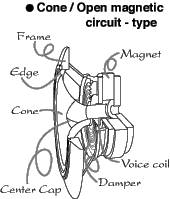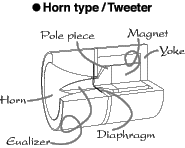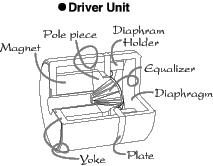Fostex
Speaker Components

Speaker Overview
- Types of drivers
- Interpretation of Catalog Specification
- Enclosures
- Enclosure Materials
- Assembly of Enclosures
Types of drivers
Drivers can be classified into several types depending on the configuration of their diaphragms. Drivers have progressed with the strength intrinsic to each type best suited for respective user's purposes, rather than any particular types of drivers having been made do for all purposes. Let's spend some time going over typical types of drivers.




Cone Type Drivers
With conically shaped diaphragms, this is the most often used type of driver. As diaphragms are called cone "paper", paper pulp has been the major source of diaphragm materials. However, a variety of materials is now available. Typically used materials, other than paper pulp, are PP (polypropylene) and carbon fiber. Application of this structure is extensive enough to cover full range drivers which can reproduce the entire audio spectrum, woofers for the purpose of bass sound reproduction, mid-range drivers intended for reproduction of medium frequency ranges, and tweeters for high pitch.
Dome Type Drivers
Diaphragms can also be dome shaped. Sound is radiated directly from domes. The advantage of this type of driver is that it has very good directionality. Its application is common for mid and high frequency reproduction. A lower-extending coverage available from many types of dome tweeters, compared to horn type tweeters, makes them reasonable and useful elements to form 2-way systems. Dome tweeters can be classified into 2 categories depending on dome materials, soft dome types where soft materials such as silk, cotton or polyester film is used, and hard dome types where hard materials such as aluminum or titanium is used.
Horn Type Drivers
This type of driver is characterized by a horn attached in front of the diaphragms. The typical application is reproduction of mid and high frequency ranges. Acoustically loaded horns provide this type of drivers with a high level of efficiency and good transiency.
The above 3 types of drivers represent most typically used sound radiation systems. Another key component of drivers is their magnetic circuits. Magnetic circuits can be classified into 2 categories if we leave out the special types.
Open Magnetic Circuits

Magnetic circuits for most drivers are built on the basis of Fleming's left hand rule. Drivers of this principle are called electrodynamic types. Of these, open magnetic circuits, using ferrite magnets in many cases, aremost often used. This structure, as illustrated in Figure 1, inevitably permits magnetic flux leakage, causing picture distortion on video monitors when they are brought close to each other. Recent technology has made it commercially possible to produce drivers where magnetic flux leakage can be cancelled for use in audio/visual applications.
Closed Magnetic Circuits

This type of magnetic circuits is constructed so a permanent magnet can be inserted in a pot shaped yoke, which is typically called a pot type yoke. Alnico magnets are the type of magnet used. Magnetic fields produced by this type of magnet are stronger than those of ferrite magnets, if their volume is equal. This structure permits no magnetic flux to leak out, making drivers acceptable for use with audio/visual systems. Despite many advantages provided by alnico magnets, the lack of economy due to the fact that alnico is an alloy containing cobalt, which is one of the rare metals, may be the only discouraging factor.















